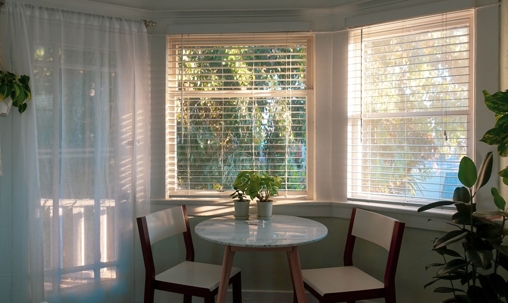Choosing the Right Dining Room Window Treatments: A Detailed Guide
Window treatments come in all sizes, lengths, fabrics, textures, and styles. The seemingly endless options may confuse homeowners looking for the ideal dining room covering. Discover why window treatment specialists consider the room's current appearance and prioritize the homeowner's desired new features when they customize window treatments for a dining room.
What Are the Best Dining Room Window Treatments?
The best window treatment dining room options depend on a few key factors, including the size of the windows, the design of your dining area, existing decor, and the homeowner's preferences. Like other interior design decisions, selecting dining room window treatments requires professional insight. The window style and treatment will affect the lighting and overall atmosphere of the dining area. Using appropriate window coverings remains essential for both a designated dining area and a flexible, open dining layout. Find the top seven window treatments for the dining room below.7 Best Dining Room Window Coverings
Window treatment specialists usually recommend blinds, shades, valances, shutters, or drapes because they remain the most suitable window treatment options for a dining room. Consumers will find a vast array of stylish window covering choices, and understanding how each one would blend with the existing dining room decor proves crucial.Wood Blinds
- Improved energy efficiency
- Enhanced UV protection
- Convenience
- Versatility
- Classic style
Roller Shades
Roman Shades
Bamboo Shades
Valances
Shutters
Drapes
20 Window Treatment Ideas for Dining Rooms
Window treatments provide the final touch to most spaces, including the dining room. A well-chosen set of coverings will enhance privacy and create a more intimate, secluded atmosphere in the dining area. Some window treatments provide the ability to manage the lighting in a room, enabling easy adjustments to the ambiance. They serve as an attractive addition to the house's decor, allowing for experimentation with various colors, textures, and patterns to freshen up the room. However, the shopping experience for them might present some challenges. The vast array of styles, colors, prints, and textures, not to mention pleats and opacities, might make the selection process overwhelming. Should you choose velvet or silk fabric for your curtains? These 20 design tips will help you find the right window treatment to meet your needs and complement your dining room décor.1. Coordinate the Hardware With a Splash of Color
An effortless method to unify the dining area involves aligning the curtain rod with the rest of the hardware in the room. Homeowners should ensure that the curtain rod they use harmonizes with the color of their light fixtures, mirrors, table legs, and any other metallic elements in the room.2. Infuse a Fresh Hue Into the Living Space
When selecting curtains for a dining room, the temptation to stick to existing colors may feel all too comfortable. However, choosing a new shade will create an impact on the current color palette. A pop of color, if not excessively vibrant, will surely catch the attention of guests without overpowering the room.3. Embrace Vibrant Colors and Striking Prints
Homeowners might assume that combining a lively hue with a daring pattern could lead to overstimulation of the senses. But, in reality, these elements frequently harmonize, working together in a complementary fashion rather than conflicting with each other.4. Enhance the Ambiance With Elegant Black Window Treatments
There are seemingly countless inspirations for a customer buying new curtains for a formal dining room. Curtains provide an effective means to tailor the atmosphere within the dining room. If homeowners desire precise management of natural light filtering through their windows, they should consider a traditional black roller shade set to ensure the desired effect.5. Use Lighter Window Coverings in Dimly Lit Rooms
When a house’s dining area lacks ample natural light, traditional curtains might not seem like a good option. However, choosing a sheer curtain set will introduce a whimsical element to the room while delivering some privacy and light control. Selecting printed curtains could create more visual interest, too.6. Balance a Colorful Room With Neutral Shades
Drapes provide an excellent means to introduce vibrant hues into the dining area. However, if the color scheme already encompasses lively tones, homeowners should use neutrals to create a subtle contrast. Look for window coverings with subdued shades to strike a balance with the existing color palette while maintaining a strong presence alongside the room's most vivid components.7. Infuse Extra Personality With Playful Prints
Homeowners often overlook patterns when shopping for window treatments, even though they add visual interest and personality to a room. However, curtains with intricate designs can enhance the appeal of any dining space—even a formal dining room. Printed curtains come in a wide array of colors and patterns, allowing homeowners to choose a look that ranges from bold to understated.8. Combine Contemporary Furniture With a Catchy Print
Curtains play a vital role in shaping the atmosphere of a room. Rather than just blending in, they possess the power to introduce a striking contrast. Consider adding a statement-making print to add an eye-catching effect to any dining area with contemporary, clean-lined furniture.9. Choose Prints That Compliment the Dining Room Rug
Selecting a print for dining room curtains presents a challenge due to the sheer number of patterns available. An effective strategy involves drawing inspiration from the existing patterns in the room. Acquire a set of curtains that align with the dining room rug. If both possess similar shapes and colors, they will harmonize nicely.10. Introduce a New Stylish Accent Print
Splashes of bold color add a lively touch, but introducing playful patterns looks equally pleasing. Consider incorporating a fresh print into an existing dining room window treatment to create contrast without introducing a new color scheme.11. Add Texture With Simple Window Treatments
When homeowners feel like their dining rooms are too loud, they should think about putting up a set of cotton, plain white curtains instead of adding more color to the room. These drapes add a little texture, offering something extra for the eyes to appreciate whenever someone enters the space.12. Maximize Elegance With Floor-to-Ceiling Coverings
Finding the perfect balance between bold and bland window treatments might seem tricky. Nevertheless, achieving this balance remains possible through simple strategies. Window treatment professionals hang simple curtains from the ceiling to the floor to create a naturally dramatic display in the dining rooms. The understated nature of the curtains helps maintain balance by neutralizing their length.13. Frame Every Window Along a Wall
Professional installation of curtains on each window is imperative, especially when embellishing a room with several windows in a row. Choose an uncomplicated design and a muted color to avoid an overpowering effect and yield an impressive, chic outcome.14. Accentuate a Bay Window for Added Visual Appeal
Curtains undergo careful crafting to suit more than the typical, rectangular windows. If a dining room has a wide bay window, seasoned window treatment experts may use a curtain rod that precisely follows the contour of the gracefully arched bay window.15. Formal Elegance With Wall-to-Wall Curtains
Homeowners do not need to tailor their drapes in the dining room to perfectly fit the window. Instead, homeowners can extend them from wall to window on one side and from window to wall on the other. This method results in drapes that cover the entire wall, creating an impressive visual effect.16. Harmonize Woven Furniture and Window Coverings
If the house's dining room has woven furniture, homeowners should consider getting woven wood shades. This harmonious design will create a cohesive and stylish look. The textures of the woven wood shades should blend well, creating a visually appealing addition to the space.17. Maintain Flow With a Curved Curtain Rod
Traditional curtain rods have a linear structure suspended by a pair of hooks. A curved curtain rod can minimize the gap between the curved walls and curtains. The distinct shape allows curtains to maintain an equal distance from the walls, creating an eye-catching look, especially when the curved walls and curtains share a similar color scheme.18. Simplify With Curtains Matching the Walls
If homeowners prefer hanging curtains and want to keep things simple, they should choose window treatment options that match their wall color. This uncomplicated selection enhances the room's appeal without causing significant alterations to the color scheme.19. Ensure Privacy With Panel Curtains
Homeowners may hang curtains for more than mere decorative purposes, prioritizing privacy over improved ambiance. For some dining areas, panel curtains may seem a good option for the windows because they provide additional privacy and block out most of the light. Sheer panel curtains can improve privacy without completely diminishing the natural light entering the room.20. Allow Natural Light for a Brighter Space
Do you appreciate the appearance of curtains, yet feel reluctant to obstruct light coming into the dining room? Utilize a pair of sheer drapes. Sheer curtains strike a balance by allowing ample sunlight into the room and providing some privacy.Are Custom Window Treatments Worth It?
Window treatments play a vital role in enhancing the overall feel of a dining room. Although they may receive occasional compliments, their functions are light control and ensuring privacy. Choosing custom window treatments for the dining rooms is worth it because they will significantly influence the room's atmosphere. They provide a cozy setting and privacy for guests given the dining room's usual position at the front of the home.
Customizing a window treatment allows homeowners to select various design elements, including size, fabric, color, texture, automation, and opacity. Moreover, a customized window treatment includes expert installation, ensuring a perfect fit for the window.



